What Was The Attitude If The Wire Services And The Newspaper Publishers Groups Towards Radio News?
Over the course of its long and complex history, the newspaper has undergone many transformations. Examining newspapers' historical roots can aid shed some light on how and why the newspaper has evolved into the multifaceted medium that it is today. Scholars commonly credit the ancient Romans with publishing the first paper, Acta Diurna, or daily doings, in 59 BCE. Although no copies of this paper take survived, information technology is widely believed to have published chronicles of events, assemblies, births, deaths, and daily gossip.
In 1566, another ancestor of the mod newspaper appeared in Venice, Italia. These avisi, or gazettes, were handwritten and focused on politics and military machine conflicts. However, the absence of printing-press technology greatly express the circulation for both the Acta Diurna and the Venetian papers.
The Birth of the Press Press
Figure 4.2
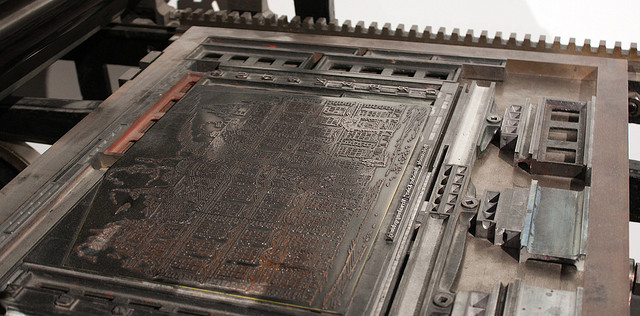
Johannes Gutenberg's printing press exponentially increased the rate at which printed materials could exist reproduced.
Milestoned – Printing press – CC BY 2.0.
Johannes Gutenberg's printing press drastically changed the face of publishing. In 1440, Gutenberg invented a movable-type press that permitted the loftier-quality reproduction of printed materials at a rate of well-nigh 4,000 pages per day, or 1,000 times more than could be done by a scribe by hand. This innovation drove down the price of printed materials and, for the start fourth dimension, made them accessible to a mass market. Overnight, the new printing press transformed the scope and achieve of the newspaper, paving the style for modern-day journalism.
European Roots
The first weekly newspapers to apply Gutenberg's press emerged in 1609. Although the papers—Relations: Aller Furnemmen, printed by Johann Carolus, and Aviso Relations over Zeitung, printed by Lucas Schulte—did non name the cities in which they were printed to avoid government persecution, their guess location can be identified because of their utilise of the German language. Despite these concerns over persecution, the papers were a success, and newspapers quickly spread throughout Key Europe. Over the adjacent v years, weeklies popped upwards in Basel, Frankfurt, Vienna, Hamburg, Berlin, and Amsterdam. In 1621, England printed its first paper under the championship Corante, or weekely newes from Italy, Germany, Hungary, Poland, Bohemia, France and the Low Countreys. Past 1641, a newspaper was printed in nigh every country in Europe as publication spread to France, Italy, and Kingdom of spain.
These early newspapers followed one of ii major formats. The first was the Dutch-way corantos, a densely packed two- to iv-page newspaper, while the 2nd was the German language-way pamphlet, a more expansive 8- to 24-page newspaper. Many publishers began printing in the Dutch format, only as their popularity grew, they changed to the larger German style.
Government Control and Liberty of the Printing
Considering many of these early publications were regulated past the government, they did not written report on local news or events. Notwithstanding, when civil war broke out in England in 1641, as Oliver Cromwell and Parliament threatened and eventually overthrew Male monarch Charles I, citizens turned to local papers for coverage of these major events. In Nov 1641, a weekly newspaper titled The Heads of Severall Proceedings in This Nowadays Parliament began focusing on domestic news (Goff, 2007). The paper fueled a discussion most the liberty of the printing that was later articulated in 1644 by John Milton in his famous treatise Areopagitica .
Figure 4.four
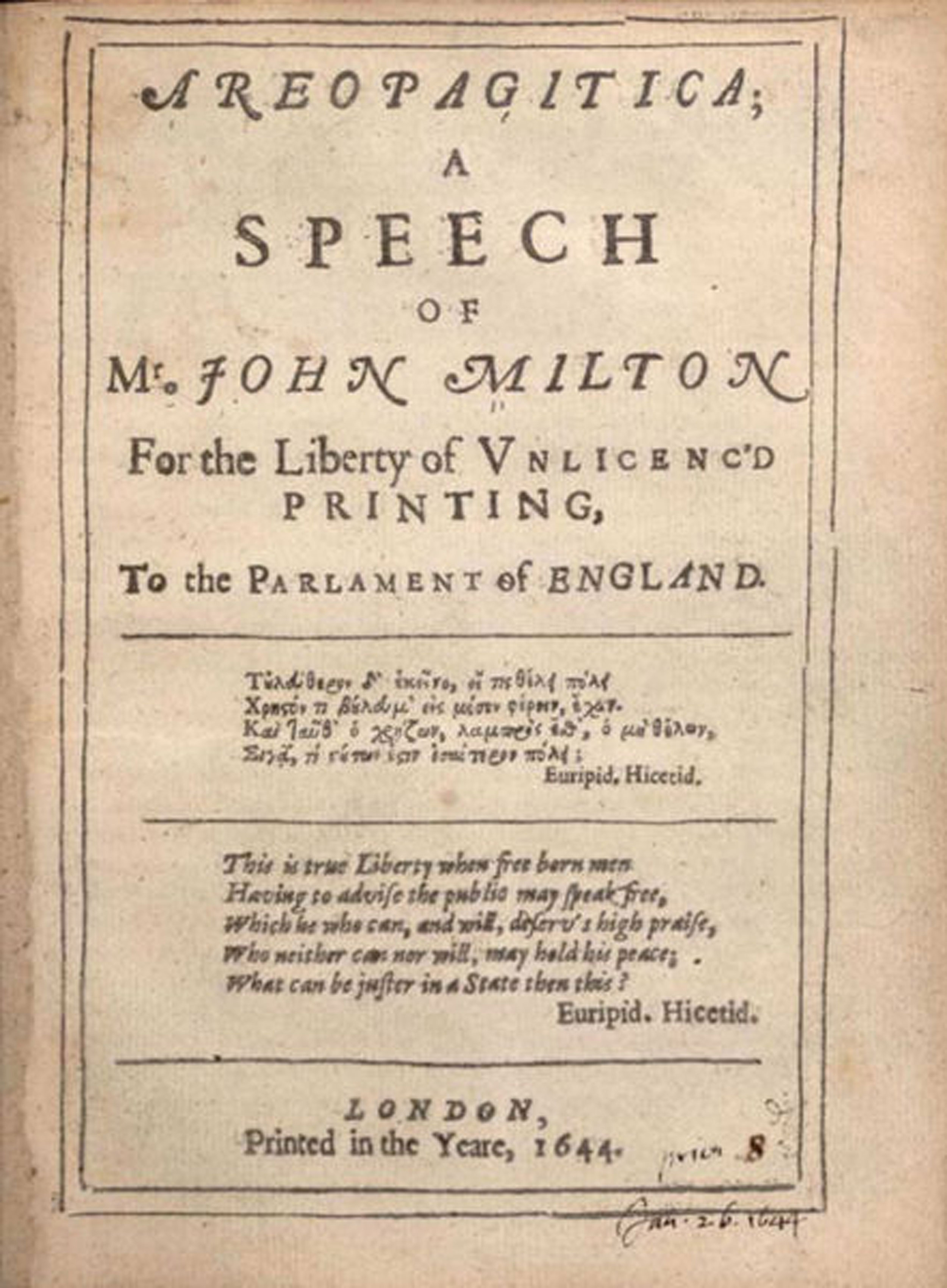
John Milton's 1644 Areopagitica, which criticized the British Parliament's office in regulating texts and helped pave the way for the freedom of the press.
Wikimedia Commons – public domain.
Although the Areopagitica focused primarily on Parliament'due south ban on certain books, it also addressed newspapers. Milton criticized the tight regulations on their content by stating, "Who kills a man kills a reasonable creature, God'south image; but he who destroys a proficient book, kills reason itself, kills the image of God, as it were in the heart (Milton, 1644)." Despite Milton's accent on texts rather than on newspapers, the treatise had a major upshot on printing regulations. In England, newspapers were freed from government control, and people began to understand the power of gratuitous press.
Papers took advantage of this newfound freedom and began publishing more than oft. With biweekly publications, papers had boosted space to run advertisements and market reports. This changed the function of journalists from unproblematic observers to active players in commerce, as business owners and investors grew to rely on the papers to marketplace their products and to help them predict business developments. In one case publishers noticed the growing popularity and turn a profit potential of newspapers, they founded daily publications. In 1650, a German publisher began printing the globe's oldest surviving daily newspaper, Einkommende Zeitung, and an English publisher followed conform in 1702 with London's Daily Courant. Such daily publications, which employed the relatively new format of headlines and the embellishment of illustrations, turned papers into vital fixtures in the everyday lives of citizens.
Colonial American Newspapers
Newspapers did not come to the American colonies until September 25, 1690, when Benjamin Harris printed Public Occurrences, Both FORREIGN and DOMESTICK. Earlier fleeing to America for publishing an commodity about a purported Cosmic plot against England, Harris had been a newspaper editor in England. The first commodity printed in his new colonial paper stated, "The Christianized Indians in some parts of Plimouth, have newly appointed a solar day of thanksgiving to God for his Mercy (Harris, 1690)." The other articles in Public Occurrences, still, were in line with Harris'due south previously more controversial style, and the publication folded after just i issue.
Fourteen years passed before the next American newspaper, The Boston News-Letter, launched. 15 years after that, The Boston Gazette began publication, followed immediately past the American Weekly Mercury in Philadelphia. Trying to avoid following in Harris'due south footsteps, these early papers carefully eschewed political discussion to avert offending colonial authorities. After a lengthy absence, politics reentered American papers in 1721, when James Franklin published a criticism of smallpox inoculations in the New England Courant. The following year, the newspaper defendant the colonial regime of declining to protect its citizens from pirates, which landed Franklin in jail.
After Franklin offended government in one case once more for mocking religion, a courtroom dictated that he was forbidden "to print or publish The New England Courant, or whatever other Pamphlet or Paper of the like Nature, except information technology be first Supervised by the Secretary of this Province (Massachusetts Historical Lodge)." Immediately post-obit this order, Franklin turned over the paper to his younger brother, Benjamin. Benjamin Franklin, who went on to become a famous statesman and who played a major function in the American Revolution, likewise had a substantial affect on the printing manufacture every bit publisher of The Pennsylvania Gazette and the conceiver of subscription libraries.
The Trial of John Peter Zenger
Figure 4.5
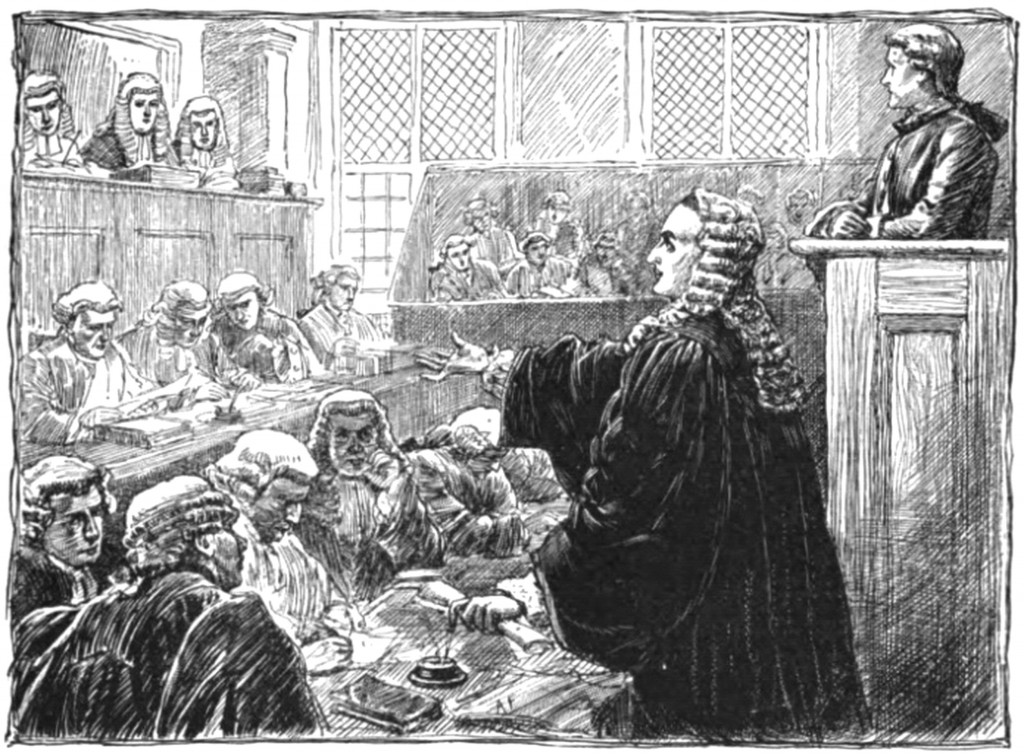
The New York Weekly Journal founder John Peter Zenger brought controversial political discussion to the New York printing.
Wikimedia Commons – public domain.
Boston was not the only metropolis in which a paper discussed politics. In 1733, John Peter Zenger founded The New York Weekly Journal. Zenger'due south paper before long began criticizing the newly appointed colonial governor, William Cosby, who had replaced members of the New York Supreme Court when he could not control them. In late 1734, Cosby had Zenger arrested, claiming that his paper contained "divers scandalous, virulent, false and seditious reflections (Archiving Early on America)." Eight months later on, prominent Philadelphia lawyer Andrew Hamilton defended Zenger in an important trial. Hamilton compelled the jury to consider the truth and whether or not what was printed was a fact. Ignoring the wishes of the approximate, who disapproved of Zenger and his actions, the jury returned a not guilty verdict to the court afterwards only a short deliberation. Zenger's trial resulted in two pregnant movements in the march toward freedom of the printing. First, the trial demonstrated to the papers that they could potentially impress honest criticism of the government without fear of retribution. Second, the British became afraid that an American jury would never convict an American journalist.
With Zenger's verdict providing more freedom to the press and equally some began to call for emancipation from England, newspapers became a conduit for political discussion. More conflicts betwixt the British and the colonists forced papers to pick a side to support. While a bulk of American papers challenged governmental authorities, a pocket-sized number of Loyalist papers, such as James Rivington's New York Gazetteer, gave voice to the pro-British side. Throughout the state of war, newspapers continued to publish data representing opposing viewpoints, and the partisan printing was born. Subsequently the revolution, 2 opposing political parties—the Federalists and the Republicans—emerged, giving rise to partisan newspapers for each side.
Freedom of the Press in the Early Usa
In 1791, the nascent United States of America adopted the Offset Subpoena as part of the Bill of Rights. This act states that "Congress shall make no law respecting an establishment of organized religion, or prohibiting the gratis exercise thereof; or abridging the freedom of speech, or of the printing; or the right of the people peaceable to assemble, and to petition the authorities for a redress of grievances (Cornell University Law Schoolhouse)." In this one sentence, U.S. law formally guaranteed freedom of press.
Withal, as a reaction to harsh partisan writing, in 1798, Congress passed the Sedition Human action, which declared that "writing, printing, uttering, or publishing any simulated, scandalous and malicious writing or writings against the authorities of the United States" was punishable by fine and imprisonment (Constitution Social club, 1798). When Thomas Jefferson was elected president in 1800, he allowed the Sedition Act to lapse, claiming that he was lending himself to "a bang-up experiment…to demonstrate the falsehood of the pretext that freedom of the printing is incompatible with orderly government (University of Virginia)." This free-press experiment has continued to modern times.
Newspapers as a Form of Mass Media
As tardily every bit the early 1800s, newspapers were nonetheless quite expensive to impress. Although daily papers had become more mutual and gave merchants upward-to-engagement, vital trading information, most were priced at about 6 cents a copy—well above what artisans and other working-form citizens could afford. Every bit such, newspaper readership was express to the elite.
The Penny Press
All that changed in September 1833 when Benjamin Day created The Sunday. Printed on pocket-size, letter-sized pages, The Sun sold for just a penny. With the Industrial Revolution in full swing, Day employed the new steam-driven, ii-cylinder printing to print The Sun. While the old printing press was capable of press approximately 125 papers per hour, this technologically improved version printed approximately 18,000 copies per hour. Every bit he reached out to new readers, Day knew that he wanted to modify the manner news was presented. He printed the paper'southward motto at the peak of every front end page of The Sun: "The object of this paper is to lay before the public, at a price within the means of every ane, all the news of the day, and at the same fourth dimension offer an advantageous medium for advertisements (Starr, 2004)."
The Sunday sought out stories that would entreatment to the new mainstream consumer. As such, the paper primarily published human-interest stories and police reports. Additionally, Day left ample room for advertisements. Day's adoption of this new format and industrialized method of press was a huge success. The Sun became the offset newspaper to be printed by what became known every bit the penny press. Prior to the emergence of the penny printing, the near pop newspaper, New York City's Courier and Enquirer, had sold 4,500 copies per twenty-four hour period. Past 1835, The Sun sold 15,000 copies per twenty-four hours.
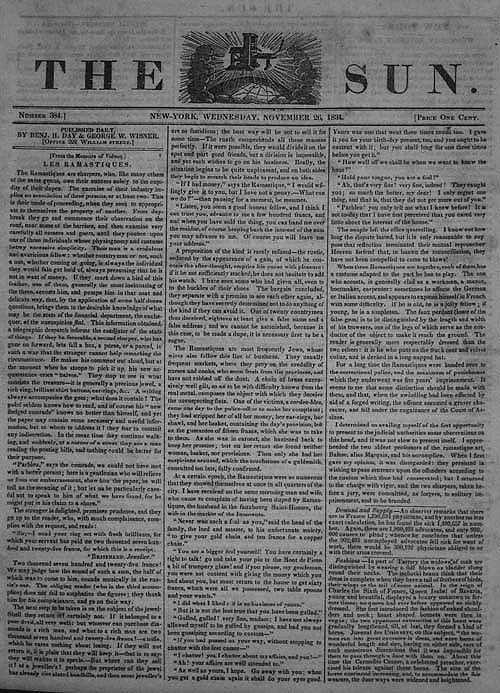
Figure four.half-dozen
Benjamin Day'due south Sun, the outset penny paper. The emergence of the penny printing helped plough newspapers into a truly mass medium.
Wikimedia Commons – public domain.
Another early successful penny paper was James Gordon Bennett'southward New York Morning Herald, which was first published in 1835. Bennett fabricated his marking on the publishing industry by offering nonpartisan political reporting. He also introduced more than aggressive methods for gathering news, hiring both interviewers and foreign correspondents. His paper was the starting time to transport a reporter to a criminal offence scene to witness an investigation. In the 1860s, Bennett hired 63 war reporters to embrace the U.Southward. Civil War. Although the Herald initially emphasized sensational news, it afterwards became one of the land's most respected papers for its authentic reporting.
Growth of Wire Services
Another major historical technological quantum for newspapers came when Samuel Morse invented the telegraph. Newspapers turned to emerging telegraph companies to receive up-to-date news briefs from cities across the globe. The significant expense of this service led to the formation of the Associated Press (AP) in 1846 every bit a cooperative organisation of 5 major New York papers: the New York Sun, the Periodical of Commerce, the Courier and Enquirer, the New York Herald, and the Express. The success of the Associated Press led to the evolution of wire services between major cities. According to the AP, this meant that editors were able to "actively collect news equally it [bankrupt], rather than gather already published news (Associated Printing)." This collaboration between papers allowed for more reliable reporting, and the increased breadth of discipline matter lent subscribing newspapers mass appeal for not just upper- but besides center- and working-form readers.
Yellow Journalism
In the tardily 1800s, New York Globe publisher Joseph Pulitzer developed a new journalistic style that relied on an intensified apply of sensationalism—stories focused on law-breaking, violence, emotion, and sexual activity. Although he fabricated major strides in the newspaper industry past creating an expanded section focusing on women and past pioneering the apply of advertisements as news, Pulitzer relied largely on violence and sex in his headlines to sell more copies. Ironically, journalism's most prestigious laurels is named for him. His New York World became famous for such headlines every bit "Baptized in Blood" and "Little Lotta's Lovers (Fang, 1997)." This sensationalist style served as the forerunner for today'due south tabloids. Editors relied on shocking headlines to sell their papers, and although investigative journalism was predominant, editors oft took liberties with how the story was told. Newspapers often printed an editor'due south interpretation of the story without maintaining objectivity.
At the same time Pulitzer was establishing the New York World, William Randolph Hearst—an admirer and principal competitor of Pulitzer—took over the New York Journal. Hearst's life partially inspired the 1941 classic film Citizen Kane. The boxing between these two major New York newspapers escalated as Pulitzer and Hearst attempted to outsell one another. The papers slashed their prices back down to a penny, stole editors and reporters from each other, and filled their papers with outrageous, sensationalist headlines. One conflict that inspired particularly sensationalized headlines was the Spanish-American War. Both Hearst and Pulitzer filled their papers with huge front-page headlines and gave bloody—if sometimes inaccurate—accounts of the war. Every bit historian Richard K. Hines writes, "The American Printing, especially 'yellow presses' such every bit William Randolph Hearst'south New York Journal [and] Joseph Pulitzer'south New York World … sensationalized the brutality of the reconcentrado and the threat to American business interests. Journalists often embellished Castilian atrocities and invented others (Hines, 2002)."
Comics and Stunt Journalism
As the publishers vied for readership, an entertaining new element was introduced to newspapers: the comic strip. In 1896, Hearst's New York Journal published R. F. Outcault's the Yellow Child in an attempt to "attract immigrant readers who otherwise might not take bought an English-language paper (Yaszek, 1994)." Readers rushed to purchase papers featuring the successful yellow-nightshirt-wearing character. The cartoon "provoked a wave of 'gentle hysteria,' and was soon appearing on buttons, cracker tins, cigarette packs, and ladies' fans—and even as a character in a Broadway play (Yaszek, 1994)." Some other outcome of the drawing's popularity was the creation of the term xanthous journalism to draw the types of papers in which information technology appeared.
Figure iv.7
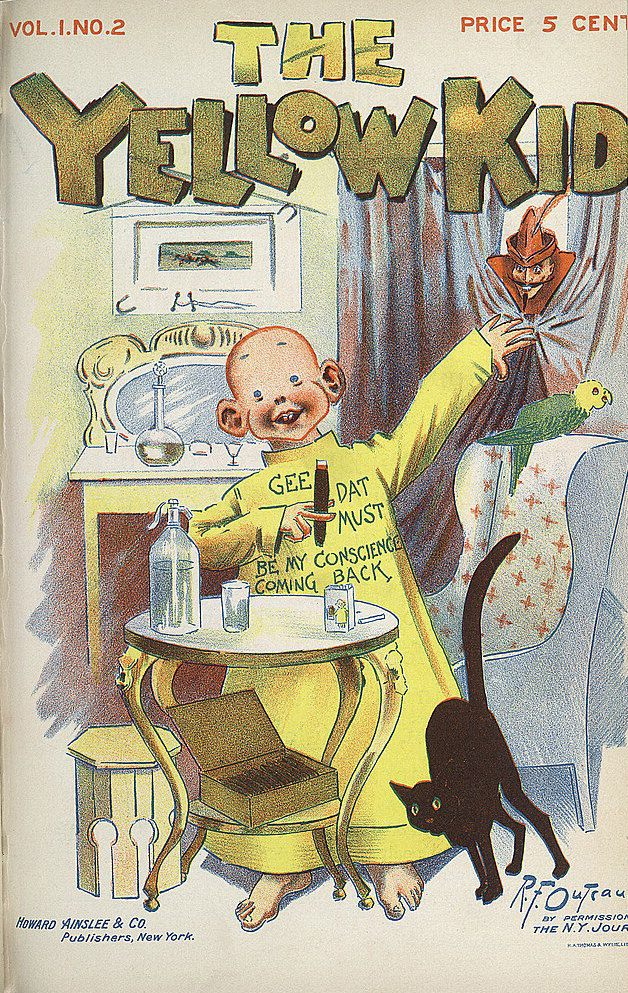
R. F. Outcault's the Yellowish Kid, first published in William Randolf Hearst'due south New York Journal in 1896.
Pulitzer responded to the success of the Xanthous Kid by introducing stunt journalism. The publisher hired journalist Elizabeth Cochrane, who wrote under the name Nellie Bly, to report on aspects of life that had previously been ignored by the publishing industry. Her first commodity focused on the New York Metropolis Lunatic Asylum on Blackwell Island. Bly feigned insanity and had herself committed to the infamous asylum. She recounted her experience in her first commodity, "Ten Days in a Madhouse." "It was a brilliant move. Her madhouse performance inaugurated the performative tactic that would become her trademark reporting style (Lutes, 2002)." Such articles brought Bly much notoriety and fame, and she became known as the commencement stunt journalist. Although stunts such every bit these were considered lowbrow entertainment and female stunt reporters were often criticized past more traditional journalists, Pulitzer's decision to hire Bly was a huge step for women in the newspaper business. Bly and her beau stunt reporters "were the starting time newspaperwomen to motion, as a group, from the women's pages to the front page, from society news into political and criminal news (Lutes, 2002)."
Despite the sometimes questionable tactics of both Hearst and Pulitzer, each man made significant contributions to the growing journalism industry. Past 1922, Hearst, a ruthless publisher, had created the state'due south largest media-holding visitor. At that fourth dimension, he owned 20 daily papers, 11 Dominicus papers, 2 wire services, 6 magazines, and a newsreel company. Likewise, toward the end of his life, Pulitzer turned his focus to establishing a school of journalism. In 1912, a year afterward his death and 10 years after Pulitzer had begun his educational entrada, classes opened at the Columbia University Schoolhouse of Journalism. At the time of its opening, the school had approximately 100 students from 21 countries. Additionally, in 1917, the first Pulitzer Prize was awarded for excellence in journalism.
Key Takeaways
- Although newspapers have existed in some form since ancient Roman times, the modern newspaper primarily stems from German papers printed in the early 1600s with Gutenberg's press press. Early European papers were based on two distinct models: the small, dense Dutch corantos and the larger, more than expansive German weeklies. As papers began growing in popularity, many publishers started post-obit the German style.
- The Sun, first published by Benjamin Day in 1833, was the first penny paper. Day minimized paper size, used a new two-cylinder steam-engine printing press, and slashed the cost of the paper to a penny so more citizens could afford a newspaper. Past targeting his paper to a larger, more mainstream audience, Day transformed the newspaper industry and its readers.
- Joseph Pulitzer and William Randolph Hearst were major competitors in the U.South. paper manufacture in the late 1800s. To compete with one some other, the ii employed sensationalism—the use of crime, sex, and scandal—to attract readers. This blazon of journalism became known as yellow journalism. Yellow journalism is known for misleading stories, inaccurate information, and exaggerated detail.
Exercises
Please respond to the following writing prompts. Each response should be a minimum of one paragraph.
- Examine ane copy of a major daily newspaper and one copy of a pop tabloid. Carefully examine each publication's writing style. In what ways do the journals use similar techniques, and in what ways do they differ?
- Exercise y'all come across whatsoever links back to the early on newspaper trends that were discussed in this section? Describe them.
- How exercise the publications use their styles to achieve out to their respective audiences?
References
Archiving Early on America, "Peter Zenger and Liberty of the Press," http://world wide web.earlyamerica.com/earlyamerica/bookmarks/zenger/.
Associated Printing, "AP History," http://www.ap.org/pages/well-nigh/history/history_first.html.
Constitution Order, "Sedition Act, (July 14, 1798)," http://www.constitution.org/rf/sedition_1798.htm.
Cornell University Law School, "Bill of Rights," http://topics.constabulary.cornell.edu/constitution/billofrights.
Fang, Irving East. A History of Mass Communication: Six Data Revolutions (Boston: Focal PressUSA, 1997), 103.
Goff, Moira. "Early History of the English Newspaper," 17th-18th Century Burney Collection Newspapers, Gale, 2007, http://find.galegroup.com/bncn/topicguide/bbcn_03.htm.
Harris, Benjamin. Public Occurrences, Both FORREIGN and DOMESTICK, September 25, 1690.
Hines, Richard Yard. "'First to Respond to Their Land's Call': The First Montana Infantry and the Spanish-American War and Philippine Insurrection, 1898–1899," Montana: The Magazine of Western History 52, no. 3 (Fall 2002): 46.
Lutes, Jean Marie "Into the Madhouse with Nellie Bly: Daughter Stunt Reporting in Belatedly Nineteenth-Century America," American Quarterly 54, no. two (2002): 217.
Massachusetts Historical Society, "Silence DoGood: Benjamin Franklin in the New England Courant," http://www.masshist.org/online/silence_dogood/essay.php?entry_id=204.
Milton, John. Areopagitica, 1644, http://oll.libertyfund.org/index.php?option=com_content&task=view&id=23&Itemid=275.
Starr, Paul. The Creation of the Media: Political Origins of Mod Communications (New York: Basic Books, 2004), 131.
University of Virginia, "Thomas Jefferson on Politics & Government," http://etext.virginia.edu/jefferson/quotations/jeff1600.htm.
Yaszek, Lisa. "'Them Damn Pictures': Americanization and the Comic Strip in the Progressive Era," Journal of American Studies 28, no. 1 (1994): 24.
What Was The Attitude If The Wire Services And The Newspaper Publishers Groups Towards Radio News?,
Source: https://opentext.wsu.edu/com101/chapter/4-2-history-of-newspapers/
Posted by: merrillfrenjudipt.blogspot.com


0 Response to "What Was The Attitude If The Wire Services And The Newspaper Publishers Groups Towards Radio News?"
Post a Comment